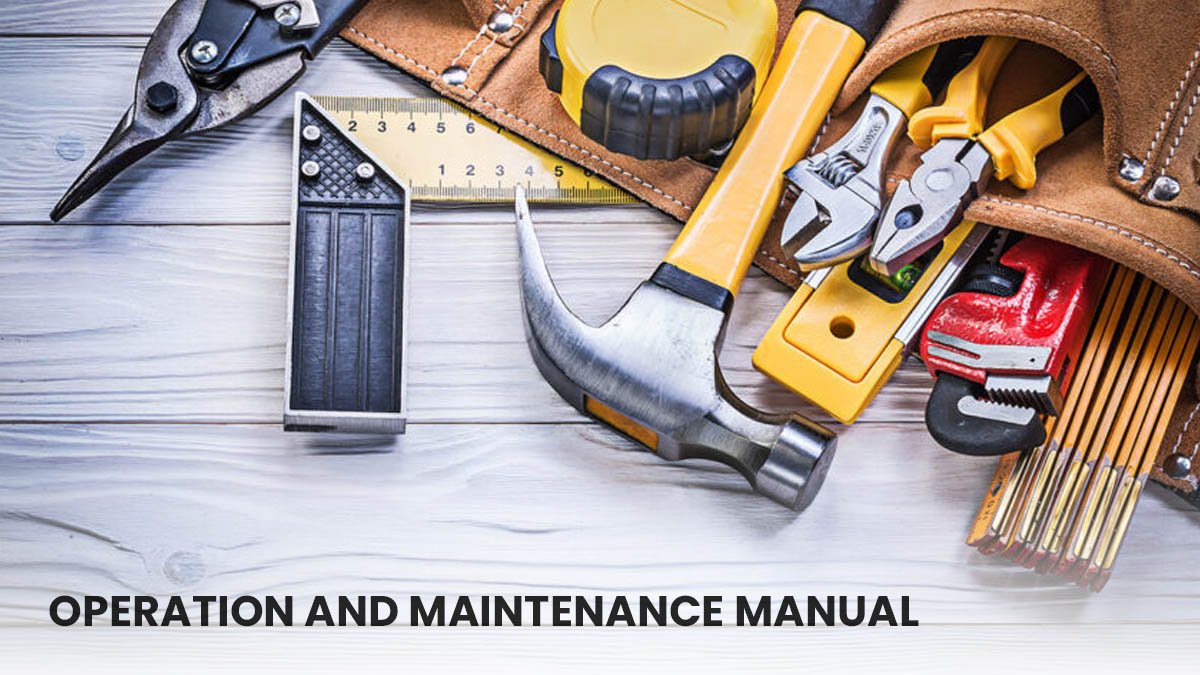
Operation and Maintenance Manual
Operation and Maintenance Manual
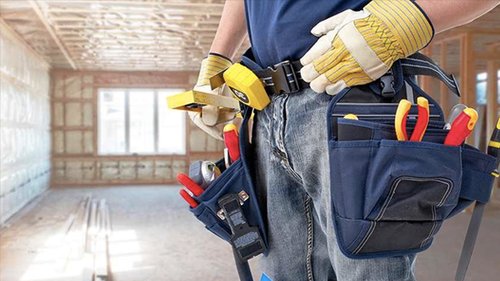
When buildings are more technologically sophisticated, architects and clients are seeking more from the key contractors and subcontractors in terms of their operational and maintenance manuals. A higher level of detail and better quality of information is required to ensure that the highest level of facility /building management is achieved even after construction. O&M Manuals are not only an integral part of the handover of buildings, but are also a legal obligation to comply with the 2007 CDM Regulations. With the significant increase in 'Green Construction' in recent years, O&M manuals also need to comply with BREEAM and LEED requirements in the industry. The benefit of having a quality and detailed O&M Manual is not only for the end user, but also for the contractors who submit the information. A U.S. study has shown that 65 to 85 % of the cost of a new building is post-construction: if the cost falls within the defect or warranty liability period, the cost may be transferred back to the installation contractor. Proper support of system activities is an integral part of maintaining consistent, ongoing operations. Information supporting operational activities can come from any number of sources, each with specific agendas but consistent in their common support of operational continuity. The challenge for operational managers is to effectively unite and communicate this information in a way that accommodates the day-to-day operating environment. One approach commonly used is the creation and distribution of Operations and Maintenance Manuals. Before crawling deep into it, we have to know what is Operations and Maintenance Manual. An Operation and Maintenance Manual (O&M manual) is a common term for a set of comprehensive procedures that federal pipeline safety regulations require pipeline operators to develop and implement.Procedures in the O&M Manual should cover pipeline operation , maintenance and response to abnormal events and emergencies. Or simply we can say a document describing the operation and maintenance procedures required of an entity or system. The Operations and Maintenance Manuals, as part of the Health and Safety Initiative, are intended to provide a detailed source of knowledge that guides the contractor and end users in their understanding of the building. The manual will describe the design of the building and its structures, as well as the processes and procedures necessary for its operation and maintenance in a secure and safe manner.
Who can prepare O&M Manual? A designer who has the experience in the production of the manuals is allowed to work on the management, coordination and production of the manuals from start to finish. They will work with the design and construction teams to ensure that a manual of the highest quality with the correct and required material is created. This would meet the needs of end-users and ensure that the contractual and professional responsibilities of our clients are discharged to the Employer in good time. Building owner's O&M manual The Building Owner's Manual or Operations and Maintenance Manual (O&M Manual) contains the information required for the operation , maintenance, decommissioning and demolition of the building. The building owner's manual shall be prepared by the contractor or subcontractor with additional information from the designers and suppliers. It is a requirement that is generally defined in the preliminary documents section of the tender document, where its contents will be described, although there may be additional requirements for mechanical and electrical services in the mechanical and electrical specification. The client should be provided with a draft version of the document as part of the handover procedure prior to the certification of practical completion. The final document is typically not published in full form until several months after functional completion, as commissioning information also needs to include summer and winter readings in the fully occupied house. Preliminary documents may include a number of copies of the building owner's manual and may include an online edition.
A building owner's manual should include:
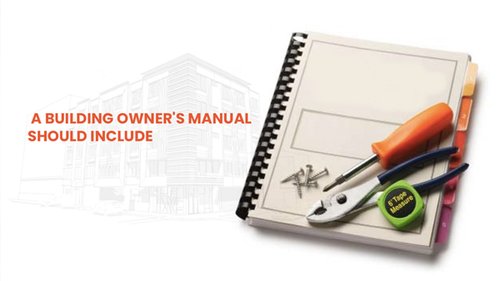
- A description of the main principles of design.
- Details of the construction of the building (such as finishing, cladding, doors and windows, roof construction, and so on).
- Built drawings and specifications.
- Operation and maintenance guidelines (including health and safety details and manufacturer 's guidance for effective and proper service).
- An inventory list for the plant and equipment.
- Evidence of commissioning and research.
- Warranties, warranties and certificates.
- Specific requirements for demolition, decommissioning and disposal.
Much of this information will already exist in one form or another, so it may simply be a matter of compiling and assembling the building owner's manual.
Throughout the life of the buildings, the building owner's manual can be established to represent improvements to the structure of the building or its structures, along with descriptions of the maintenance that have taken place. The building owner's manual may also include a non-technical 'building user guide' with information for users on environmental controls, access, safety and security systems, etc.
O&M Manual Template
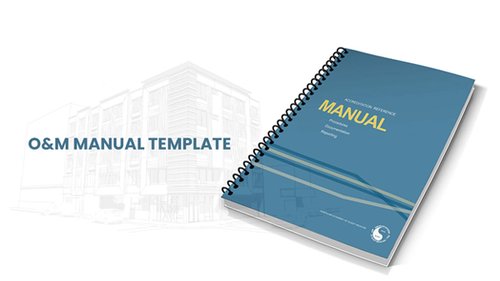
The contents of the O&M manual for inclusion in the final documentation may seem confusing, as the term has a broad meaning for all project transfer documentation. However, one thing is certain that the contents of the O and M manual are substantially more than a few ring binders of information thrown together. In short, the O&M manual AKA "Operation and Maintenance Manual" (O&M Manual) is a file containing all the information required for the operation , maintenance, decommissioning and demolition of a building or structure. Nowadays, the O and M manual is usually produced using a cloud-based software solution as part of a construction project software rather than a manual hard copy process. The manual is unique to each area of the project, from hardware, electrical , plumbing, gas, etc. Each manual shall be prepared by either the manufacturer, the subcontractors, the service engineers and the other contracted suppliers. The contents of the O and M Manual is a requirement that has been defined as part of the tender documentation where its contents are outlined. This can be subdivided into parts or even stand-alone manuals covering machinery, mechanical and electrical installation services in the mechanical and electrical specification section.
An electronic soft copy or draft version of the contents of the O and M manual would normally be provided to the client as part of the handover procedure prior to any final sign-offs for completion. The final manual will then be created online for reviews, edits and updates so that authorized staff can access it 24/7 or print it to a hard copy for distribution. Preliminary documents in the tender or contract contracts that include a number of copies of the O&M manual, so that electronic versions are recommended to avoid being too labour-intensive.
The contents of the O and M Manual may include a wide range of documentation:
- Comprehensive explanations of the core concepts of design or architecture.
- Lists of building standards (including dimensions, finishes, cladding, doors and windows, roof design, etc.).
- Versions and revisions of drawings and specifications.
- Documentation on commissioning and various test results.
- The inclusion of guarantees, guarantees and certifications.
- Clear guidelines for its use and maintenance (covering health and safety records, equipment and manufacturer 's instructions for effective and proper service).
- A full list of assets of all plants and equipment built.
- Outlines or instructions relating to maintenance, maintenance , operation, demolition, decommissioning and disposal.
The challenge in creating O&M Manual contents is that while most of this information is likely to exist, it is intended to simplify the preparation, compilation and assembly of its various components. Also, as updates and revisions are a normal function within the industry, the use of software avoids any delays or out-of-date versions. Another smart idea is to use the O and M Manual models to reduce manual rework. That over the life of the building or structure, the manual must adapt to reflect the changes that have taken place in the building, its equipment or systems, along with records of all maintenance that has taken place. In conclusion , the objective of the O and M Manual is to optimize the functioning of buildings and their equipment with clear documentation on maintenance guidelines, specifications, warranties, inspections, approvals and sign-offs for the proactive management of their operation.
O&M Manual planning is one component of a much broader knowledge transfer process. Transferring knowledge is necessary to facilitate the transition of the projects product from the project stage into continuing operations. An O&M Manual contains information and strategies designed to guide operational stakeholders in the normal use and maintenance of the projects product. The manual should be written in such a way as to encourage actions and responses to anything that can arise during normal product operations and maintenance. The actual type of manuals produced, the information they contain, and the defined stakeholder responses are derived from information inputs from areas such as:
Project Team O&M Manuals help transfer knowledge, lessons learned from product development and testing, from the Project Team to the Operations Team. Operations Support Environment O&M Manuals document the operational processes, tasks and responsibilities associated with ongoing operations and maintenance in the production environment;
Operations Activities O&M Manuals save time and cost by reducing the misuse of common operating activities by the use of descriptive, recorded, step-by - step instructions.
Operations Education O&M Manuals can be used as teaching tools; encouraging stakeholders to make simple system operations and maintenance decisions that may otherwise be mishandled;
Every O&M Manual is uniquely designed to meet the particular needs of its mission. It is not uncommon, particularly for large complex structures, for multiple manuals to be created for different divisions, work functions, activities, etc. Some common types of O&M Manuals are:
- Installation and maintenance manuals for products
- Overview of program, processes, backup and recovery manuals
- Manuals for Data and Software Administration
- Manuals on human resources and personnel
- Help desk support guides
- Manuals for users
- Emergency and Safety Guide
- Quick Guide to Reference
- Work assistance
Irrespective of what is written, the O&M Manual should be viewed as a living text, remaining versatile to accommodate changes that will eventually arise as the organization matures. O&M Manuals can contain information on subjects such as:
- Options for installation and configuration and associated definitions
- System maintenance, updates, and upgrade policies , procedures, and schedules
- The correct and improper handling and repair of various types of equipment;
- Database schema, network topology, and flowcharts used to demonstrate elements such as device architecture , data communications, program logic, and relationship between network nodes
- Guidelines for opening / closing and starting / stop processes, devices and facilities under different conditions
- Procedures and sequences describing backup routines, type of media, locations of storage, and schedules
- Security controls for personnel, facilities , infrastructure and emergency response procedures;
- Regularly asked questions and troubleshooting strategies on specific issues
- Roles , responsibilities and contact information for key personnel and support staff;
- Other miscellaneous and/or relevant item
Best Practices
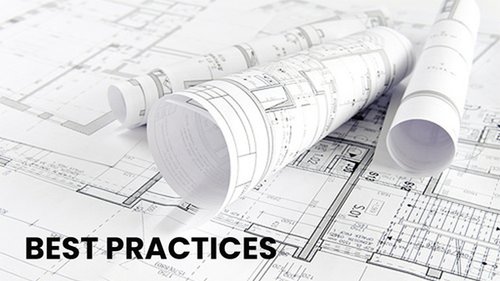
The following best practices for the development of the Operation & Maintenance Manual are recommended:
- Simple Build O&M manuals so that they can be read and understood even by individuals who are not familiar with the topic being recorded.
- Accessibility Stakeholders should be able to easily download the latest version of every O&M document from an accepted venue, such as a community website.
- Jargon Evitate technical jargon and ambiguous acronyms whenever possible
- Regulations Identify the relevant regulatory requirements
- Manuals Provide as many manuals as possible to promote the continuity of operations;
- Style Adopt and maintain clear layout, text, sectioning, etc. across documents
- Authors / Editors Where necessary, name a single author and publisher.
- Align Align the O&M Manuals with the procedures and processes of the company.
- Update O&M Manuals are living documents and should be revised as variable changes impact.
- Educate educate stakeholders and employees and constantly improve O&M procedures, systems, policies and standards
- Lessons-Review of the O&M Manuals previously used. Lessons learned from key personnel involved in their development can identify specific lessons learned that are relevant to current operational activities.
Practice Activities
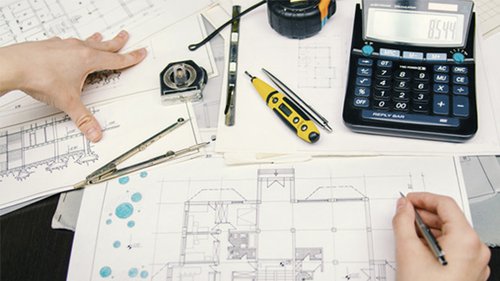
- Identify the type of O&M Manuals required
- Identify the sources of information and the information to be included in each manual.
- Identify and engage relevant stakeholders and subject matter experts (SME)
- Identify and integrate SME inputs
- Develop an O&M Manual
- Receive sufficient stakeholder approval and print manuals
- Plan testing, training and exercises to strengthen and validate the O&M Manuals;
- Educate staff through training and awareness campaigns;
- Log lessons learned and integrate them into future O&M Manual updates.
- Maintain O&M Manuals as a living text, update them periodically to keep up-to - date with operational and system changes
How to build a manual for service and maintenance

The task of producing a convenient service and maintenance manual is to make it detailed without being dull. Put some thought into preparing the manual so that it can really have an effect on the bottom line in the long run with improved productivity and organization.
- Choose the platform : With today's technology, you should be able to find a portal that allows you to continue updating and changing your operating and maintenance manual as required. Printed manuals or even those written in word processing documents are very difficult to update. You also run the risk of outdated manuals floating around the organisation.
- Create a consistent and easy-to - read template : You 're going to want your manual to be easy to scan, and you're going to want your employees to be able to locate the required sections quickly. By ensuring consistency across the board, you will make the manual more valuable to all its users.
- Involve managers in the production of manuals: Ask the front-line supervisors for feedback as they actually build the intestines of the service and maintenance manual. You are the ones who ask questions and see inefficiencies and mistakes and you want to understand what you think is the most important way to communicate. If they are interested in the production of the manual, they will be more engaged and help to encourage its use and enhancement.
- Encourage feedback and improvements: Be sure to ask for feedback, especially in the early days of manual use. As employees turn to this resource, they will have further questions or suggestions. Provide a program in place to study and incorporate the best recommendations to make the operations and maintenance manual more useful over time.
Operation and maintenance manuals can be a valuable resource for your entire maintenance team. Invest the time to put one together if your organization does not already have one. Note that you can upload it to your maintenance program to make it easier to use.
Creating an O and M Building Manual prototype When you're nearing the end of a construction project, you need to think about creating an Operation and Maintenance Manual (O and M) for asset transfer. Failure to provide complete documentation could delay the successful completion of the construction project. So, leaving the compilation of the O and M manual until the last minute can have big consequences. Collecting details during the project makes the process simpler for everyone. Plan ahead for the building handover so that all is well organized for the day of handover. This makes it a smooth , easy process, and avoids disputes and damage to reputation.
What's to put in the O&M manual?
Everything used and installed in a building project comes with information from the manufacturer. This will include requirements, warranties, and details on service and maintenance. It makes sense to give it to the new owner.
- Manufacturing and maintenance information, product data sheets, specifications, safety data sheets and drawings
- Description of item
- Installation information like location and any sketches for installation
- Details on the testing and commissioning of each object
- Information on warranty
- Details of manufacturer and supplier
- A maintenance matrix that sets a maintenance schedule in a table for ease of usage.
Keeping it simple These days, creating an O and M manual template is as simple as you can. You can compile the information and make the document yourself. Using a word processing tool like Word or a digital process to create O and M compliant, professional digital or cloud-based manuals. You can also recruit someone to do it for you. Paper-based documents are quickly becoming redundant in today's world. Apart from the waste and costs of paper documents, digital technology has come a long way. Using a digital platform makes compiling a manual super quick.
Digital Operation and Maintenance Manual
The old style of the conventional O&M manuals is out of date and was based on old technology only at that time. There are detrimental drawbacks that can typically lead to a variety of problems like:
- 1.Lost OR Destroyed: Hard copies can be misplaced, discarded or lost in transit.
- 2.OUTDATED INFORMATION: As different sections are updated by different departments, some hard copies are often not updated.
- 3.DELAYS: It takes a long time to repair and redistribute all hard copies.
- 4.IMPEDED COORDINATION: Outdated and inaccessible information causes confusion between all parties and thus hinders collaboration.
- 5.TIME-CONSUMING: Navigating through hard copies to locate knowledge can be time-consuming, time-consuming, and daunting.
- 6.LIMITED FUNCTIONALITY: Paper manuals are not interactive and may only display printed information.
- 7.ACCESS: not having an O&M manual ready means that information can not be accessed; our solution allows easy access from a variety of devices.
- 8.STORAGE: Storing a manual takes up an unnecessary amount of space.
The use of technology over traditional paper manuals facilitates accessibility, makes it easier to update information and offers more functionality. The Digital O&M Manual is an online building management system that integrates all information (from O&M manuals, H&S files, drawings, etc.) into one convenient location. It has been designed for intuitive use by all parties and is as simple as possible to prevent incompatibility issues with mobile phones, browsers, etc. and serves as a useful tool for clients. The Digital O&M Manual can be used as a collaborative tool for all subcontractors to upload all required handover information, which is essential for smooth handover and successful post-handover construction.
What is included in the typical electrical O&M manual?
The main aim of O&M Manual is to act as a reliable source of knowledge for the owner / customer after the completion of the project.They will refer back to it when they need information about the operation of any equipment or ordering material. It outlines the construction of the building and all its systems, as well as the procedures for the operation and maintenance of the facility. All of this knowledge will allow the owner / customer to feel the need to call an electrician or another contractor for permission. This includes all submitted for the project, including equipment, lighting, appliances, generators, fire alarm, protection, and more. All of these items were sent to the owner who then approved the materials and equipment to be ordered, including color combinations, types and styles. The manual also contains warranty letters and inspection certificates for potential reference. Subcontractors must also complete a manual for their applications, which is included in the final O&M manual. As-built sketches are eventually inserted as soon as the project is finished, displaying the final layout. The O&M is usually put together by the Project Management Assistant, with the help of the Project Manager, near the completion of the project. Technically, this can be accomplished as long as all applications have been accepted and there are no modifications to the content and equipment, but the modifications are unavoidable, and it is better to wait until the end of the project and that nothing is lost or has to be reworked.
The benefits of digital O&M Manual

- Flexible and easy to maintain reports and dashboards that provide a clear image of the project at a glance.
- Eliminate the need to move and store hard copy files.
- Make data available on easily secured digital media
- Control ratings and approvals
- Follow the contractual transition criteria by creating a personalized folder structure that represents the specifications of the contract.
- Ensure that all stakeholders are engaged by receiving information through the workflow process.
- Track the progress of all subcontractors, consultants and vendors to ensure that there are no surprises at handover.
- Revise the guides to remain up to date with the asset lifecycle Features of Digital O&M
- A folder tree structure that can be built to your requirements to allow simple navigation
- Permissions that can be customized to control who can see the information
- A bespoke workflow process to ensure all information is reviewed and approved as required
- Bulk upload of data and files
- The ability to link key records
- Export data in common formats such as xls and XML
- Produce snapshots of all or part of the database that can be handed over to tenants, the client and any other stakeholders
Format of Operation and Maintenance Manuals for Buildings
The O&M manuals have a vital role to play as a reference source for the new Project Owner or Client. If well operated and maintained, the life of a building and its engineering services will exceed the service period. It is therefore essential for the new owner or operator to quickly gain a clear understanding of the proper operational and maintenance needs involved. The design and delivery of a well-prepared O&M manual is therefore an integral part of any construction service installation contract. A variety of variables can affect the final format of any O&M manual. The type of manual required must be adapted to meet the specific requirements of the project. However, the format will also be influenced by the specific installation and categories of manual users involved. It is also important that the requirements of more than one level of reader need to be taken into account when compiling a manual. Generally, O&M manual users fall into three broad categories:
- The owner / occupier of the building
- Those responsible for operating and maintenance management
- Those who are maintaining
The different parts of the manual are likely to be addressed to these different categories of users, the contents should be subdivided and assembled to meet their needs. The non-technical owner / occupier of the building requires a very general overview of the systems installed and is therefore likely to refer only to those sections of the manual that will provide it; - Introduction to integrated building systems
- Description of the overall function of the facility
- General details on the running of the plant
- However, the maintenance manager will require a much more detailed briefing, including;
- Contract and legal details
- a detailed description of the installed systems
- Identification of parts and required replacement parts
- Schedules of equipment
- Policy on Savings
- Device commissioning / testing data;
- Device (specific) operation;
- (general) maintenance;
- Manufacturers' names and addresses
- Index of drawings
- emergency information
- Maintenance technicians and professionals engaged in the service of the device from a realistic point of view have even more basic specifications of the manual:
- Detailed data on operation and performance
- Commissioning / testing data
- Instructions for maintenance (specific to the plant)
- The literature of the manufacturers
- The contents of the manual may either be carefully assembled to take into account the specifications described above or can be arranged into a set of manuals. It is likely that there will be a need to create separate documents for the following, particularly for large and complex installations
- Schedules of equipment
- Data on commissioning / testing
- Operation Issue
- Maintenance service
- Manufacturers' names and addresses
- Manufacturer's Literature
However, in each case, the type of the manual required and the most suitable layout should be defined at an early stage in the planning procedures and the necessary specifications set out in the specification.
Facility Operation & Maintenance Manual
It is now widely recognized that O&M represents the greatest cost of ownership and operation of the facility over its life cycle. The accuracy, relevance and timeliness of well-developed, user-friendly O&M manuals are becoming increasingly important. It is therefore becoming increasingly common for comprehensive, facility-specific O&M manuals to be prepared prior to commissioning. The objective is to support the facility's life-cycle effectively and efficiently by reducing unplanned shutdowns and allowing life-cycle savings. - Data on the system-level O&M
- Physical description
- Comprehensive O&M facility manuals should include:
- Functional description
- Troubleshooting:
- Preventive maintenance (Processes and Schedules)
- Remedial maintenance (repair requirements)
- Lists of parts
- Operation-/Maintenance-Significant drawings
- Equipment-specific O&M information, organized in a vendor / manufacturer data library
As environmental design is an important part of every facility management strategy, the O&M Manual offers a way to minimize operational costs as part of a holistic maintenance program that includes a maintenance schedule. The O&M Manual Content and Format Specifications are communicated by a comprehensive Statement of Work (SOW) customized to the needs of the Owner's Facility Management ( FM). This effort should be considered during the planning and design phases and is usually carried out during the construction phase. Building Information Modeling ( BIM) and, in particular, COBie, introduced at the front end of the project, helps to facilitate the entire process.
O&M manuals should be designed in a modular, building block format, to simplify the integration of new / additional data, such as adjustments in design / configuration, and to represent as-built conditions. The manual should be available no later than the start-up / start-up facility. However, fast track programs can be 'front-end loaded' to meet immediate objectives; i.e. only that information needed to train personnel in preparation for start-up/commissioning systems can be developed first. This can then be combined with the Owner 's overall O&M manual for completion and turnover within a defined timeframe. The use of the Start-up / Command Manual offers an important opportunity for its contents to be checked against activated systems. The efforts of qualified professional authors , editors, developers, teachers, 3D modelers, illustrators and software specialists will ensure that the Owner receives detailed, site-specific (as-built) and user-oriented documentation of the highest quality. Those chosen for the job will have the following capabilities:
Collect relevant data through interviews with personnel, engineers, equipment manufacturers / installers / integrators, etc., submissions, and on-site testing of installed systems / equipment and associated physical data collection
Review, analyze and assess the system-level facility using the engineering / technical data obtained.
Identify / develop procedures needed to achieve the most effective integration of systems.
Design the contents of the O&M Manual using terminology recognized by maintenance staff with general professional experience.
Provide a high level of trust to the staff of the Owner, e.g. through accurate content and user-friendly format
System-level O&M procedures do not replace the manufacturer's documentation for specific parts of equipment, but rather supplement those publications and guide their use. For example, system-level troubleshooting will fail-analyze the component level, such as the pump, valve or engine, then refer to specific manufacturer 's requirements to remove / clean / inspect / repair / test or replace the component.
Training for new personnel is considered to be a vital component of operation and maintenance, especially when new equipment is installed or new technology is used. It is important for the overall facility management program that the staff of the facilities be properly instructed and motivated. Training courses will inform staff about the procedures necessary to operate and maintain complex systems and equipment, often using the system-level O&M manual as a basis for information. O&M manuals, which are equally suitable for use in training, can be provided both in paper and as an on-line interactive electronic manual (IEM) developed using web-based and other accepted applications (html, xml, PDF, etc.). Training should be ongoing to keep pace with changes in the facility's technology and equipment.
O&M Manual and Health And Safety File
The O&M Manual and the Health and Safety File are two documents that you will need for most construction projects. Both documents are required upon completion of the project. These are two separate documents. Supplied together sometimes, given separately sometimes. Both documents are required upon completion of the project. And, there may even be some overlap in the content. But these are two different documents, though. Supplied together sometimes, given separately sometimes. Simply saying, the O&M manual provides information on the operation and maintenance of the building. The health and safety file includes details on the health and safety of the potential use and maintenance of the house.
The O&M manual, or the Operation and Maintenance Manual, is a bit like the owner's manual that you get with your car. Except that it's for a building or a structure. Some people even call it the building owners' manual. It is not a specific document on health and safety, but it may contain some information on health and safety. Or, of course, information that would help from a health and safety point of view. The obligation to include details on operation and maintenance is typically included in the construction contract, particularly for larger projects.
Whereas the Health and Safety File is a document required by the Construction (Design & Management) Regulations (also known as the CDM). This document is legally mandated by the CDM, a set of health and safety regulations that apply to any construction project. As the name suggests, the health and safety file is a folder that is unique to health and safety. Unlike the O&M Handbook, the health and safety file focuses on supplying information to the customer. Data required for potential use, repairs, cleaning of buildings, and any possible projects. Unlike the O&M manual, the health and safety file only includes material related to health and safety.
Well, what are the differences?
There are four major differences in Operation and Maintenance Manual and Health and Safety File.
Legal Requirements: The health and safety file is required under the Construction (Design & Management) Regulations by law. The O&M manual is usually a requirement of the construction contract.
Information: The O&M Manual contains all information on the operation and maintenance of the building. The health and safety file only contains information relevant to health and safety.
Size: The health and safety file will typically be smaller as it focuses exclusively on health and safety. You don't need to include any of the instructions, plans, and certificates in the O&M book. It should only refer to specific information on health and safety.
Use: These two documents are intended to serve two different purposes. If you need to know how to do something, or when to do it, look at the O&M manual. If you need to know if something is safe to do, or if there is a hazardous material, look in the health and safety file.
The differences between the O&M manual and the health and safety file are now evident. There are also some similarities and overlaps of information. If you need details in both papers, you don't need to repeat it. Information can be cross-referenced when it is applicable to both documents.
Lets start with the simple way to create a website.

Interested in Domitos? Get the Features Guide Today!
Domitos, is world's most sought after facility Management System and we look forward to work with. Digitize your facilities today!